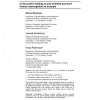Free Online Productivity Tools
i2Speak
i2Symbol
i2OCR
iTex2Img
iWeb2Print
iWeb2Shot
i2Type
iPdf2Split
iPdf2Merge
i2Bopomofo
i2Arabic
i2Style
i2Image
i2PDF
iLatex2Rtf
Sci2ools
IJBRA
2007
2007
Is the protein folding an aim-oriented process? Human haemoglobin as example
: The model for protein folding (in silico) simulation is presented. Three steps have been implemented: • early stage folding based on the backbone conformation • hydrophobic collapse based on the fuzzy-oil-drop model • aim-oriented structure modification by the function-related ligand. The model has been verified taking and haemoglobin chains as examples to fold them in two different conditions: with and without haem being present in the folding environment. The presence of haem and its participation in the folding simulation led to the structure more similar to the crystal one. It suggests that the haem presence directs the folding process towards the function-related structure.
| Added | 14 Dec 2010 |
| Updated | 14 Dec 2010 |
| Type | Journal |
| Year | 2007 |
| Where | IJBRA |
| Authors | Michal Brylinski, Leszek Konieczny, Irena Roterman |
Comments (0)

